What if I told you there’s a way to make your entire shipping process feel seamless? From order imports to label printing, fulfilment, and tracking, it all comes down to harnessing the right shipping technology.
Shipping technology is the engine that powers smooth, efficient, and scalable logistics for ecommerce businesses of all sizes.
It does more than just speed things up; it enhances your accuracy and drastically reduces human error.
In this guide, you’ll discover how to use shipping technology to transform your shipping strategy from a clunky, error-prone process into a smooth-running machine.
Shipping Automation Explained: How It Works & Why It Matters
The key to understanding why shipping technology matters so much comes down to one word , automation. Shipping automation leverages advanced software tools to replace manual, repetitive tasks with streamlined, efficient, and error-free workflows.
With automation, tasks like importing orders, creating shipping labels, and providing tracking updates no longer slow down your operations. Instead, they happen seamlessly, significantly reducing human error and operational delays.
It also frees up your time to be able to dedicate more time and effort to other areas of your business that are more important for moving the needle and growth.
However, successfully improving your business through shipping automation requires understanding which software suits your specific needs. With a wide range of software available, selecting the right ones is crucial for maximising efficiency and results.
Multicarrier Shipping Solutions
Multicarrier shipping solutions allow ecommerce retailers to compare rates, delivery times, and services across multiple courier providers from a single dashboard.
Rather than locking yourself into a single carrier or jumping between websites for quotes, multicarrier software puts all your courier options in one place. You can easily compare services and choose the best carrier for each shipment based on speed, cost, destination, or parcel size.
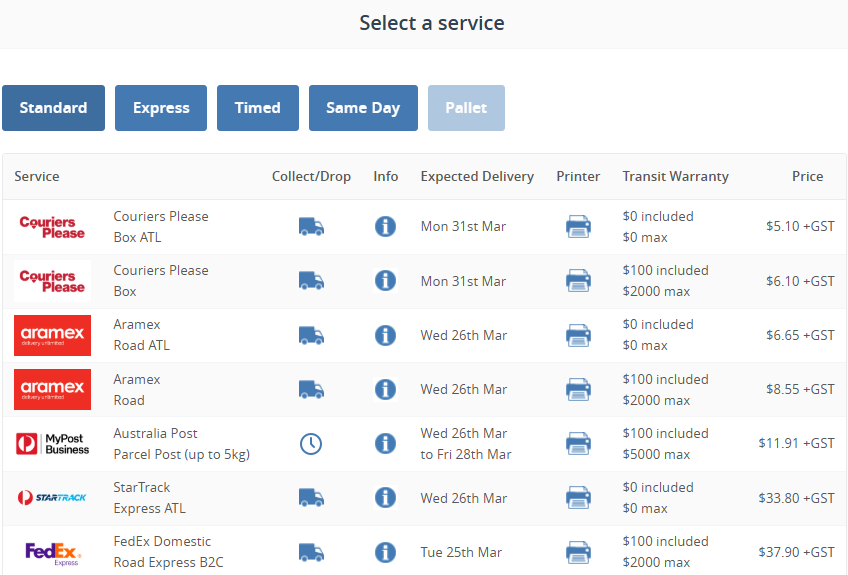
This flexibility empowers small and medium-sized businesses to:
- Reduce shipping costs by selecting the most cost-effective service for each shipment
- Improve delivery performance by choosing reliable couriers for specific routes
- Offer more options to customers, such as express or same-day delivery
Over time, this kind of flexibility becomes a strategic advantage, not just a convenience. As shipping costs fluctuate and customer expectations rise, having the ability to adapt your delivery options on a per-order basis can make a noticeable difference in both profitability and customer satisfaction.
Whether you're navigating local deliveries or expanding into international markets, multicarrier shipping technology provides the foundation to scale efficiently, without locking your business into a single provider or process.
At Interparcel, we’ve found that businesses who make full use of multicarrier shipping solutions often experience faster fulfilment times and spend significantly less time managing their shipping.
This approach can be especially transformative if you’re still shipping manually yourself. By automating repetitive tasks, multicarrier tools reduce workload and human error. That said, for businesses with very low order volumes, manual shipping may still be the simplest and most cost-effective method, at least in the early stages.
Fulfilment Automation Tools
For many ecommerce businesses, fulfilment starts manually and stays that way longer than it should. Without shipping software, fulfilling an order typically looks like this:
- Log in to your courier account (e.g. Australia Post, Aramex, or FedEx)
- Manually enter the customer’s address and order details
- Add in dimension and weight for each parcel
- Choose a shipping service
- Download and print each label
Now multiply that process by 20, 50, or 100 orders, and the inefficiencies start to pile up.
Even when using multicarrier shipping software that syncs your orders from platforms like Shopify, WooCommerce, or Squarespace, there’s still one key step that slows things down: you still need to manually select a courier and service, or any other details that must be added to the shipment.
That’s where fulfilment automation comes in.
Fulfilment automation tools allow you to build logic-based rules that make these decisions for you , automatically. Once your orders sync into your shipping dashboard, the software will apply the rules you've set without any manual input.
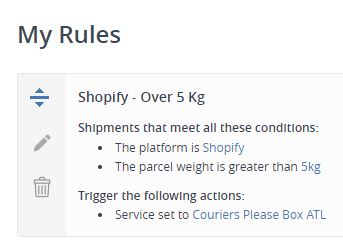
For example:
- Automatically assign couriers based on delivery country → e.g. Send all USA orders via express international service
- Group small items into a single parcel → e.g. Combine multiple small products into one box if under 2kg total weight
- Add transit cover for high-value orders → e.g. Automatically include a warranty for shipments over $100
- Route bulky or heavy parcels to specialist couriers → e.g. Use a tail-lift courier for orders over 20kg
- Add pickup addresses based on sales channel or warehouse location → e.g. Set a different sender address for orders coming from Amazon vs Shopify
These kinds of rules may seem like small changes, but together, they transform your shipping workflow from a manual, decision-heavy process into a streamlined system that runs in the background.
Live Shipping Rates
Shipping costs have a significant impact on both your profit margins and your customers’ buying decisions. While free shipping is a common tactic to reduce cart abandonment and boost conversions, it’s not always sustainable, especially for businesses shipping heavy or bulky items.
Live shipping rate tools offer a smart alternative. They pull real-time pricing and service availability directly from courier systems, giving you accurate delivery costs and timeframes based on each customer’s location, order size, and parcel weight.
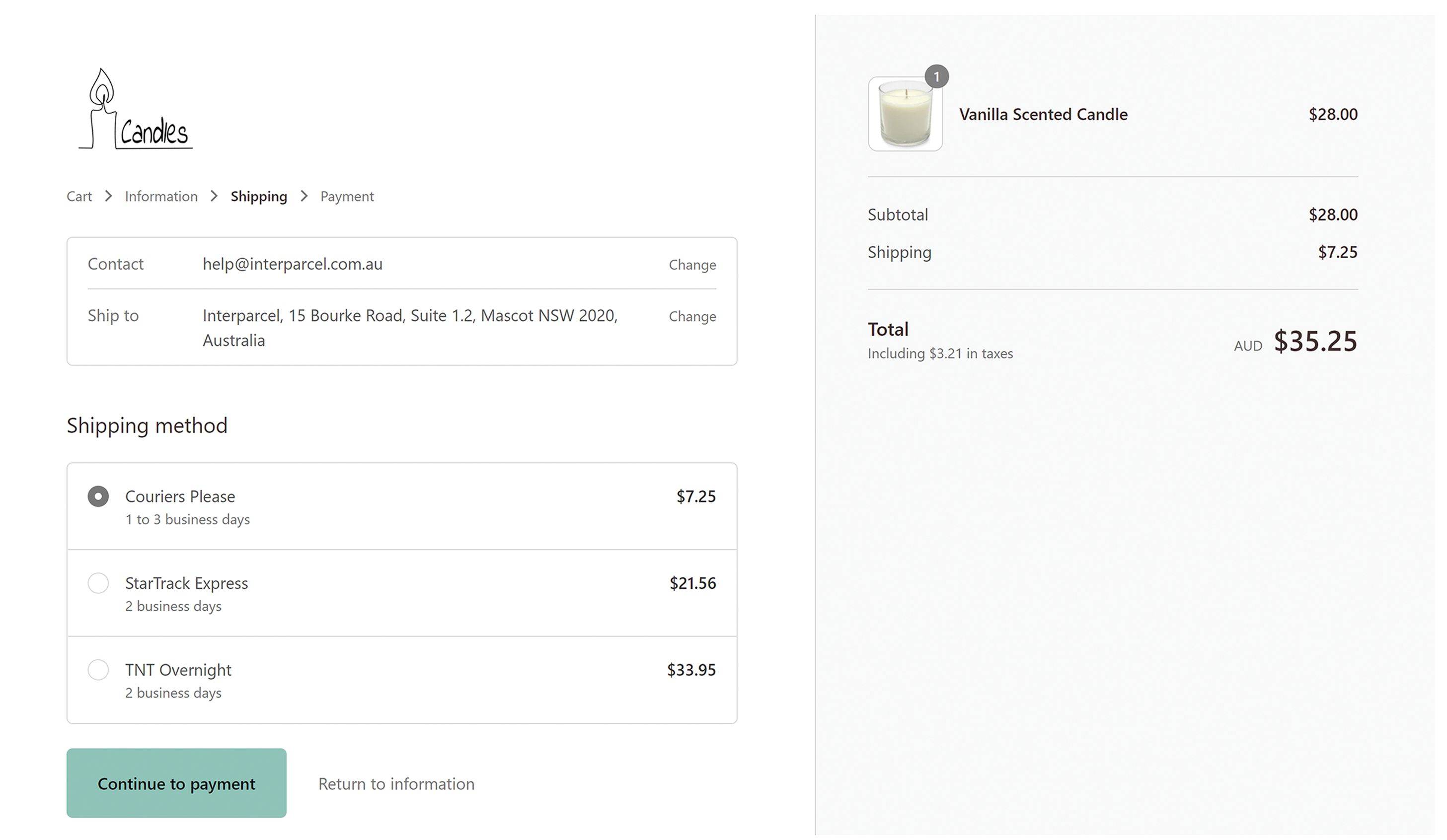
But perhaps the most valuable benefit is choice.
By displaying multiple live courier options at checkout, you give customers the power to select the service that suits them best.
This means you can:
- Let shoppers decide between fast delivery or lower cost
- Offer premium or cheaper options without covering the expense
- Cater to returning customers who favour certain couriers
This level of flexibility builds trust, increases conversions, and gives customers a better experience without forcing your business to absorb the cost of free shipping.
Picking and Packing List Tools
In the fast-paced world of ecommerce, accuracy and efficiency in order fulfilment are paramount.
Packing errors not only lead to increased operational costs but also risk customer dissatisfaction and potential loss of business. Implementing robust picking and packing list tools can significantly mitigate these risks by providing clear, organised checklists tailored for your fulfilment operations.
A picking list serves as a consolidated guide for warehouse staff or solo operators, detailing all items required to fulfil multiple orders.
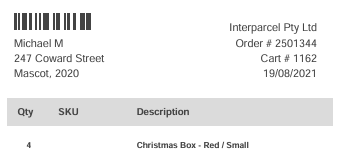
Some of the key features include:
- Group products by SKU to simplify shelf navigation and speed up picking
- Shows exact quantities needed for each item to prevent mistakes
- List’s item names, sizes, colours, or variants for accurate identification
- Includes date stamps to track when the list was generated and assist with record-keeping
By utilising picking and packing lists, businesses can streamline the collection process, especially when handling large volumes of orders, thereby enhancing overall operational efficiency.
Smart Boxing Technology
As parcel volumes rise and carrier pricing becomes more sensitive to dimensions, smart boxing technology is emerging as a key innovation in modern fulfilment.
Rather than relying on manual packing decisions, this tech uses algorithms to determine the most space-efficient way to pack items within a shipment.
By analysing product dimensions, weight, and box inventory, smart boxing ensures each order is packed with minimal waste and cost.
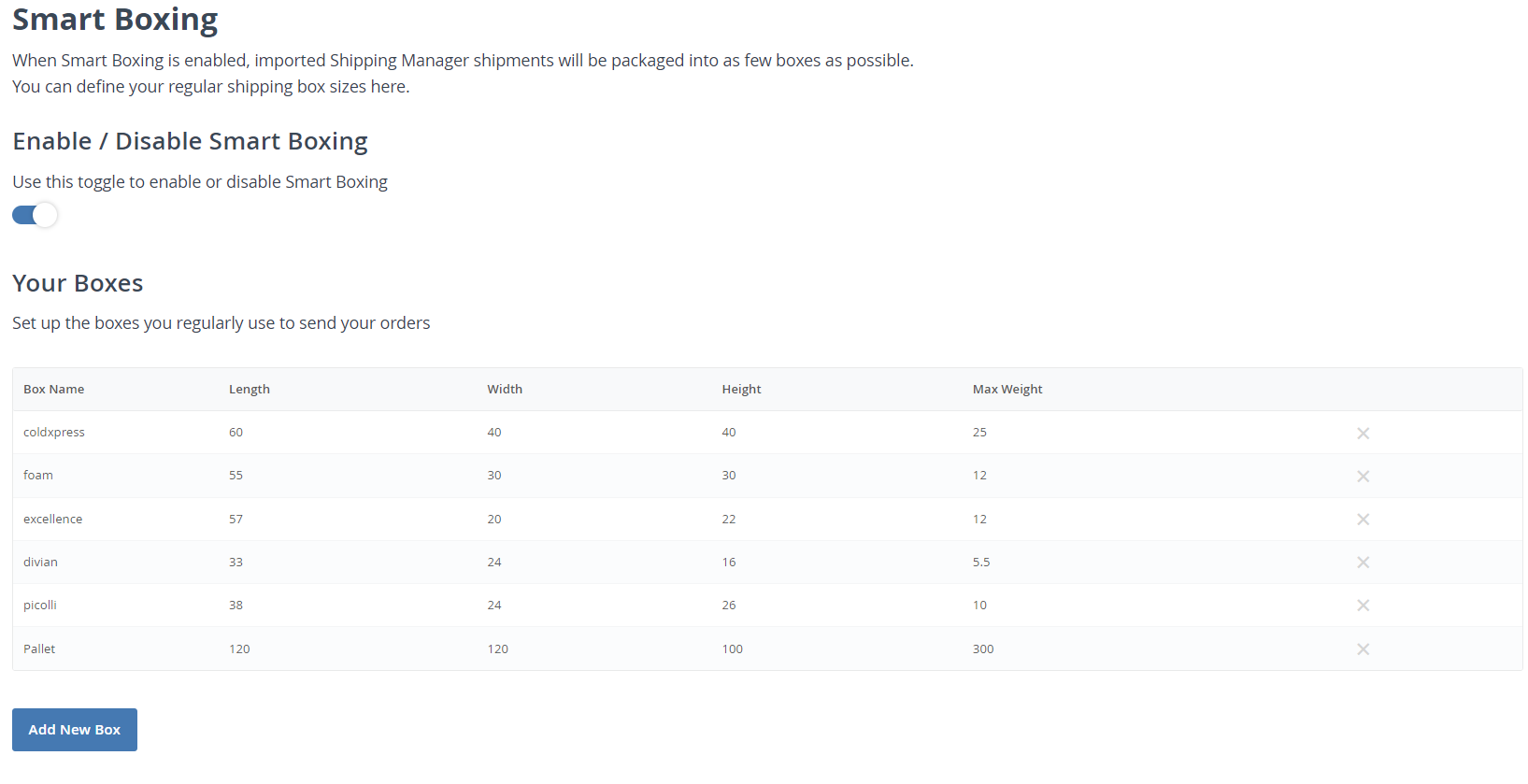
Some of the ways it can be helpful include:
- Lower shipping costs by reducing the risk of oversized parcel charges
- Faster fulfilment by eliminating guesswork in box selection
- Reduced packaging waste, aligning with sustainability goals
Smart boxing plays a crucial role in bridging the gap between logistics efficiency and customer satisfaction, making it a practical tool in your shipping tech stack.
Branded Tracking Software
Post-purchase experience is often overlooked, but it can make or break customer satisfaction.
Branded tracking tools let you customise the entire tracking journey with your own colours, messaging, and branding. More importantly, they keep customers informed with real-time updates from the moment their parcel is picked up to when it arrives at their door.
These tools often include:
- SMS or email notifications at key delivery milestones
- A central tracking hub adopted with your brand colours and logo, where customers can view updates
By offering a more transparent and branded tracking experience, you not only reduce "Where's my order?" support tickets, but you also build trust and repeat business by making customers more familiar with your brand.
Shipping Label Printing Software
How you manage your shipping labels is important is important , more important than you think.
When you’re fulfilling more than a few orders a day, manually downloading and printing labels can quickly become one of the most frustrating time-wasters in your shipping process.

Not only is it repetitive, but it’s also prone to mistakes, wrong sizes, unreadable barcodes, and wasted paper.
Shipping label software solves this by giving you the ability to:
- Batch print labels across multiple orders in seconds
- Send labels directly to a thermal printer, ideal for the industry-standard 6x4 label size
- Avoid manual formatting like resizing PDFs or copying and pasting addresses
- Assign label preferences automatically based on parcel weight, dimensions, or service type
This is especially powerful when used alongside fulfilment automations or pick-and-pack workflows, helping you move from packing to printing without delays.
How to Choose the Right Shipping Software for Your Business
No two businesses are run the same way, and just as every online store has its own niches and specialisations, so do shipping platforms.
It is important to do your research and look around before selecting your shipping platform in order to find one that aligns well with the way you run your business.
If you're unsure what to look for when choosing a shipping platform, consider these key factors.
Ease of Integration
It’s best to find a platform that integrates seamlessly with your existing ecommerce system. Whether you’re using Shopify, WooCommerce, or another platform, the ability to sync orders from your store to the shipping platform automatically will save you a lot of time and reduce the risk of errors.
Carrier Options
As explained above, a multicarrier system gives you a great advantage when shipping. It is important to understand that a multicarrier system is only as good as the carriers it can offer. A high number of carriers might sound great, but it's worth little if none of them can ship to your customer’s locations at an affordable rate. Look for platforms that offer a variety of different carriers that provide a selection of options and advantages, so you can always find a suitable and cost-effective option.
Future Potential
As your business grows larger, you will likely want to expand into the international market - or perhaps you already have. When selecting your shipping platform, don’t just think of the now - keep the future of your business in mind. It’s a good idea to ensure your platform of choice supports international shipping and provides competitive rates for global deliveries.
Customer Support
In ecommerce, customer support is of vital importance. Bad word of mouth spreads quickly, and when customer orders are delayed or incorrect, you can find yourself losing customers fast. Shipping issues are bound to arise at some point, and oftentimes, you can only support your customer as much as your shipping platform can support you. It’s important to choose a platform with human support teams who are on hand to help you resolve any issues as quickly as possible, keeping both you and your customers in the loop.
By weighing up the pros and cons of different shipping platforms, you will be able to find the one that best suits your business. Whether it’s a smooth integration with your favourite carrier or ecommerce system, great international shipping rates, or optimal customer support, each shipping platform will have selling points that appeal to different businesses.
If you’re looking for a way to access all these tools without juggling multiple systems, one option is to use a platform like Interparcel, which brings everything together in a single dashboard.
How to Compare Different Shipping Software
When you’re researching and comparing different shipping platforms, here are a few more things to keep in mind:
Ease of Use
Look for easy to use shipping platforms that have a clear and easy to read layout. It should not be difficult to automate your most time-consuming manual processes, such as order imports. If you’re finding yourself wasting time trying to figure out and set up a complicated automation process, it defeats the purpose.
Scalability
It would be a shame to choose a platform, only to outgrow it and have to adapt to another. Choose software that can grow with your business. Consider possible long-term needs, such as international shipping or more complex logistics that can be sped up and error-proofed with shipping automation tools.
Customisation
As your business grows, your shipping needs will grow, too. Ensure that your shipping software can be customised to suit your specific requirements and needs.
Item Suitability
Ensure that shipping software caters to any specific needs. For instance, if you ship dangerous or refrigerated goods, be sure to check the prohibited and restricted items lists to make sure your items can be shipped by the platform.
A well-suited shipping platform should be easy to use, provide access to a range of quality carriers, and provide the tools to help your business streamline processes, reduce your workload, and increase your bottom line.
Take Your Shipping to the Next Level
Shipping is no longer just an operational task, it’s a core part of the customer experience in ecommerce.
From order sync and label generation to tracking and packaging, the right technology can transform your shipping operations from a daily bottleneck into a powerful business advantage.
Whether you're just starting out or scaling quickly, investing in the right shipping software gives you the tools to streamline fulfilment, reduce errors, cut costs, and exceed customer expectations.
By understanding your shipping needs and exploring solutions that integrate automation, multicarrier access, and operational tools in one place, you’re setting your business up for faster fulfilment and long-term growth.
Shipping may be complex, but the right tools can make it feel simple.




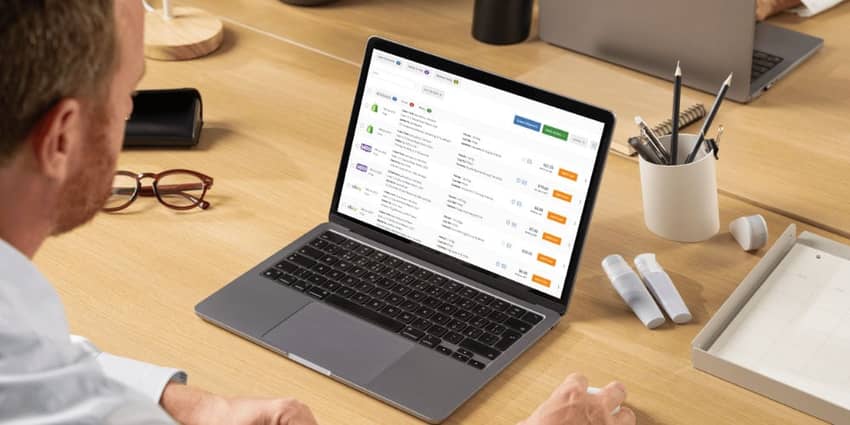





 Facebook
Facebook Twitter
Twitter Instagram
Instagram Linked In
Linked In YouTube
YouTube